|
|
|
|
|
|
|
Achi-Kochi Japan
Showing many places to visit and foods to eat in Japan
|
|
|
|
|
|
|
|
|
|
|
|
|
Japan
> Kinki region
> Katsura Rikyu ( Imperial Villa ), Kyoto
|
|
|
|
|
|
|
Katsura Rikyu ( Imperial Villa )
Kyoto, Kinki ( Achi-Kochi Japan )
|
|
|
|
|
|
|
|
|
|
|
|
|
( "Achi-Kochi" in Japanese means "Here and there" in English. )
Katsura Rikyu ( Imperial Villa ), Kyoto
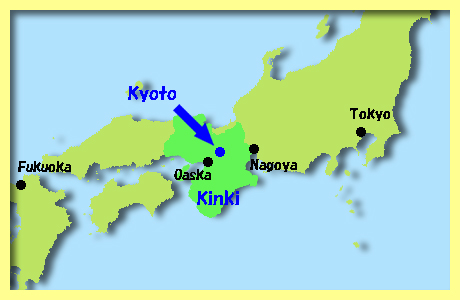
Kyoto ( above ) had been the capital city of Japan for more than one thousand years since A.D.794 until A.D.1869 when Tokyo became the capital city where Edo-jo Castle became Kokyo ( the Imperial Palace ) after Tokugawa Shogunate was overthrown in A.D.1868 ( ==> A History of Japan vol.2 After Samurai ).
Even after the Emperor moved to Tokyo, there in Kyoto remain Palaces, Villas, temples and shrines related to the Imperial Family such as Katsura Rikyu ( Katsura Imperial Villa ). It is said that there in the villa is the most beautiful Japanese garden.
Though access to the villa is strictly limited, visitors could join guided tours to walk in the garden.
|
|
The Most Beautiful Japanese Garden

Tourists, who join the guided tours, could enjoy viewing the landscape of the most beautiful Japanese garden ( above ) in Katsura Rikyu ( Katsura Imperial Villa ). The garden can not be crowded with too many people. So visitors could enjoy walking quietly.
Katsura Rikyu ( Katsura Imperial Villa ), located in the southwest of Kyoto, was built by two imperial princes ( Toshihito Shinno and his son, Toshitada Shinno ) and completed in A.D.1645.
|
|
Construction and Maintenance
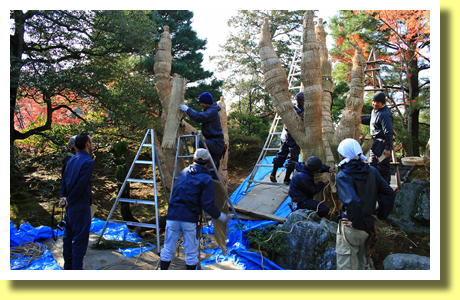
To maintain the beautiful garden, many gardeners are to be involved ( above ) in Katsura Rikyu. It costs so much. Needless to say, the construction cost much more than the maintenance does. Toshihito Shinno ( Imperial Prince ) devoted so much to build and expand Katsura Rikyu.
His son, Toshitada Shinno got married with a daughter of the feudal lord of Kaga Domain, the largest feudal domain in Tokugawa Period. It helped Toshitada Shinno devote more resources to expand the villa. ( The capital city of Kaga Feudal Domain was Kanazawa. )
So in Katsura Rikyu ( Imperial Villa ), a pond was dug, hills were formed, various trees were planted, rocks were placed, a palace and five teahouses ( four of which remain ) were built. Tourists could walk around them.
|
|
Shokin-tei ( teahouse )
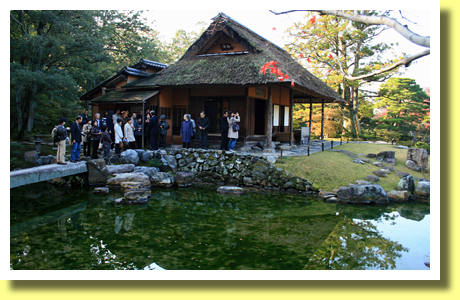
Shokin-tei ( above ) is one of four teahouses remaining in Katsura Rikyu. Though Shokin-tei is a small building with thatched roof looks like a rustic house, it is the most refined teahouse in the villa.
|
|
Nijiri-guchi of Shokin-tei ( teahouse )

The above photo shows Nijiri-guchi ( entrance ) to a tea room in Shokin-tei. Nijiri-guchi entrance is surprisingly small so that a person with a sword could not enter nor a person of high position enter without bowing his head. A tea room is a peaceful place for tea ceremonies without social discrimination.
|
|
Inside Shokin-tei ( teahouse )
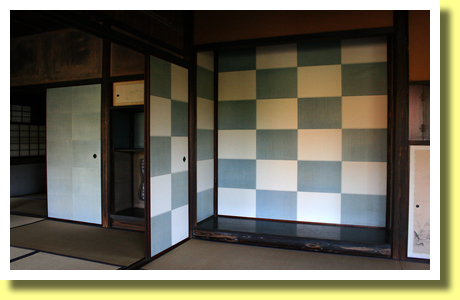
Other rooms inside Shokin-tei are interesting such as the 1st room ( above ) is impressive for blue-and-white chequered pattern, which looks modern though built almost 400 years ago.
|
|
Across the Pond

A path near Shokin-tei teahouse provide tourists with a fine landscape ( above ) of the pond and some buildings including Shoin ( the main structures of the villa ) and Geppa-ro ( teahouse ), which were built in the 17th century.
|
|
Shoka-tei ( teahouse )
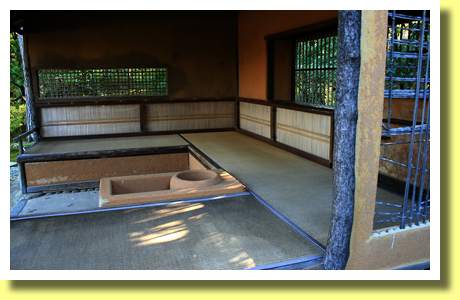
Shoka-tei is a small teahouse, located on the top of a small hill and surrounded by cherry trees. People might have enjoyed tea in the atmosphere of a mountain hut. Shoka-tei was destroyed by a typhoon in A.D.1934 and was restored.
|
|
Onrin-do ( temple )

Onrin-do ( above ) used to be a temple where a private Buddha statue had been kept, though it is now empty.
|
|
Landscape near Onrin-do ( temple )
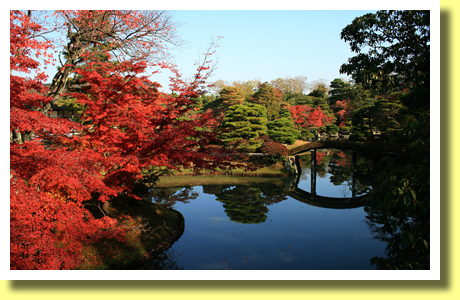
The above photo shows a landscape from a path near Onrin-do. Tourists could enjoy viewing various landscapes while walking in Katsura Rikyu ( Imperial Villa ).
|
|
Shoi-ken ( teahouse )
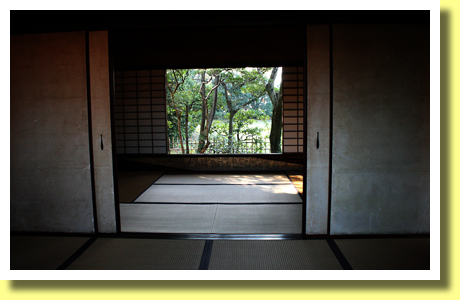
A path leads tourists from Onrin-do to Shoi-ken teahouse. The entrance of the teahouse faces the pond, while tourists could see rice paddies through the window ( above ). The rice paddies were purchased by The Imperial Household Agency so that the atmosphere of a farmhouse is preserved.
|
|
Shoin
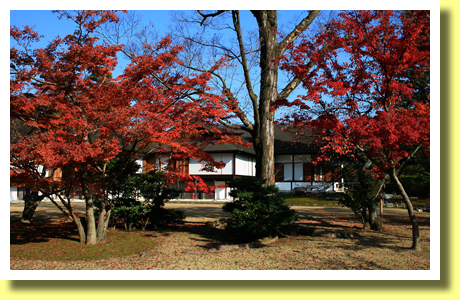
Shoin ( above ), the main structure in Katsura Rikyu, consists of three buildings ( Ko-shoin, Chu-shoin and Shin-goten ). Ko-shoin was built around A.D.1615 and Chu-shoin around A.D.1641. Shin-goten ( New Palace ) was built around A.D.1660 before the former Emperor Go-mizunoo visited the villa in A.D.1661.
|
|
Tsukimi-dai
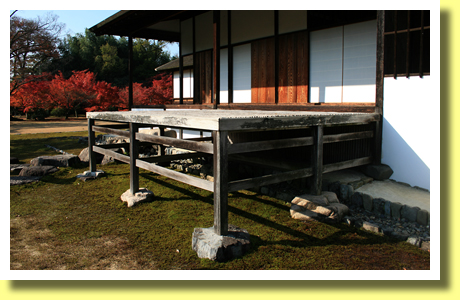
There is a terrace called Tsukimi-dai ( above ) attached to Ko-shoin facing the pond. "Tsukimi" in Japanese means "moon viewing" while "dai" does "terrace". So "Tsukimi-dai" means "Moon Viewing Terrace". The Imperial Princes on the terrace might have enjoyed viewing Moon shining over the pond in the garden.
|
|
Geppa-ro ( teahouse )
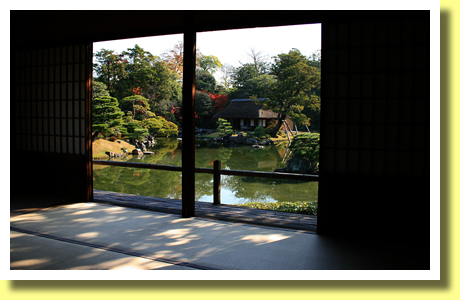
Geppa-ro teahouse is located next to Ko-shoin. One of its windows faces the pond and Shokin-tei teahouse ( above ) in the garden. Geppa-ro was built around A.D.1652.
|
|
Chumon ( gate )
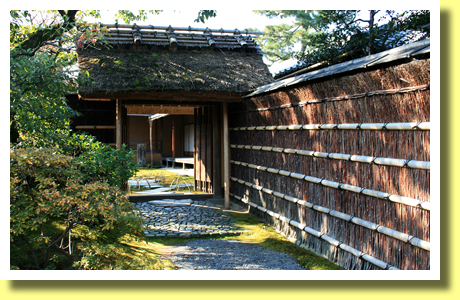
Guests, invited by the Inperial princes, were expected to enter Ko-shoin through Chumon ( gate - above ), inside which guests would find the front door of Ko-shoin.
|
|
Tsuitate no Matsu
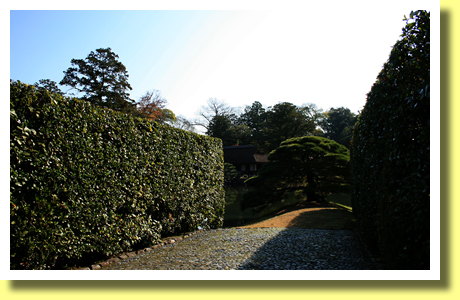
Guests, visiting Ko-shoin, would have seen Tsuitate no Matsu ( above ) before entering through Chumon gate. Tsuitate no Matsu is a pine tree which was planted beside the pond to block guests from viewing the whole garden at once.
So guests would have been impressed when enjoying the view of the whole garden from Tsukimi-dai attached to Ko-shoin. "Tsuitate" in Japanese means "screen" while "Matsu" does "pine tree". "Tsuitate no Matsu" is "a pine tree planted as screen".
|
Daimyo Gardens
If interested in Japanese Gardens, it could be recommended to visit Daimyo Gardens, built in Edo ( now Tokyo ) by feudal lords during Tokugawa Period as well as Kenroku-en in Kanazawa.
Copyright (c) 2021 Achi-Kochi Zanmai Co., Ltd.
|















